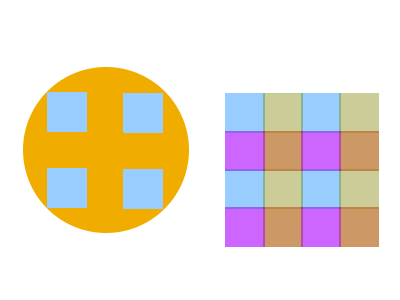The UKIRT Wide Field Camera (WFCAM)
The opportunity arises from an innovative new instrument being
designed for UKIRT - the Wide Field Camera, which will have an
instantaneous field of view of 0.21 sq. degs (Henry et al 2000, SPIE
Proceedings, Vol 4008, p.1325). Details of the camera are provided on
the project web pages. As UKIRT is a 4m class telescope,
and is on a site with excellent seeing and low temperature, the
effective survey rate (field of view divided by point source detection
time) is one or two orders of magnitude faster than just about
anything else on offer. There are only two rivals. IRMOS on the VLT is
almost as fast at J and H but has no K-band facility, and will spend
most of its time in spectroscopic mode. Furthermore it will only be
used for a small fraction of the time, whereas with WFCAM we are
proposing precisely to dedicate most of future UKIRT time to
completing an ambitious project of world significance. The other rival
is of course VISTA, which will have an even more impressive IR mosaic
camera, but will not begin operations until several years after WFCAM,
and will operate in a separate hemisphere. We see WFCAM partly as a
pathfinder for VISTA, and this is one reason why we have designed a
targeted suite of surveys rather than a monolithic atlas.
The key novel feature of WFCAM is the forward-Cassegrain Schmidt-like
camera design, which makes possible the wide field of view (40 arcmin)
on a telescope not originally designed for this purpose. The mosaic
camera has four 2048X2048 Rockwell arrays with a pixel size of 0.4
arcsec. This gives an instantaneous field of view of 0.21
sq. degs. However the arrays are spaced by 0.9 detector widths (see
Fig. 1.1). The pixel size somewhat undersamples the expected median
seeing of approximately half an arcsecond. (Note that tests indicate
that the tip-tilt system on UKIRT primarily corrects wind-shake, so
that the image size across the whole field of view is expected to be
that of the free-atmosphere seeing). However the intention is to
micro-step by sub-multiples of the pixel size, as the 2MASS project
have successfully done, producing a properly sampled (and much
larger!) image, with a somewhat broadened PSF compared to the natural
seeing. Complete sky coverage can then be achieved by any one of
several mosaic patterns. This always involves some overlaps of
course, because of the 90% detector spacing. The effect of this is
considered fully later.

Figure 1.1. Left: Focal plane arrangement of
WFCAM. Each array is 2048X2048 pixels, with pixel size 0.4
arcsecond. The spacing between arrays is 0.9 times the detector
width. The instantaneous coverage is 0.207 sq. degs.
Right: Filled-in tile after 2X2 macro-steps. Allowing
for the overlaps, the tile width is 3.85 detectors, i.e. 0.88 degrees,
giving an area of 0.77 sq. degs.
The likely speed of the camera on the sky has been estimated using
recent experience with the UFTI camera on UKIRT. We do not yet know
the DQE of the Rockwell arrays or the final realised throughput of
WFCAM, but we have assumed that point source speed is the same as UFTI
except that DQE should be somewhat better at J and H - around 45%
versus the UFTI 30%. The UFTI measurements were based on a simple
software aperture. We have therefore made a further small correction
to represent what we should be able to achieve with optimal PSF
fitting. The final result, approved by the WFCAM project scientist, is
that in half-arcsecond seeing we will achieve S/N=5 in one hour
integration for a point source with J=22.1, H=21.2, and K=20.8.¹
For a variety of reasons, and judging by figures quoted by various
other IR camera projects, these may be somewhat conservative
figures. On the other hand of course, half the time the seeing will be
worse than the median. UFTI experience suggests that in 1 arcsec
seeing the point source sensitivity is 0.3-0.4 mag worse. For the
moment we believe the sensitivity figures above are the most sensible
for preliminary survey design purposes.
Another important characteristic is the minimum sensible exposure
time, in order for elapsed time not to be dominated by overheads (see
section 1.7). This is around 40 seconds exposure per sky
position. This is discussed in detail later. Here we note simply that
this leads to the fact that the shallowest sensible survey already
reaches K=18.4.
¹ These are point source sensitivities - detection of
extended sources such as galaxies may be considerably slower. Note
also that here and throughout, the magnitudes we quote are on the Vega
system. This includes reference to SDSS survey depths, which we have
converted to Vega equivalents.
